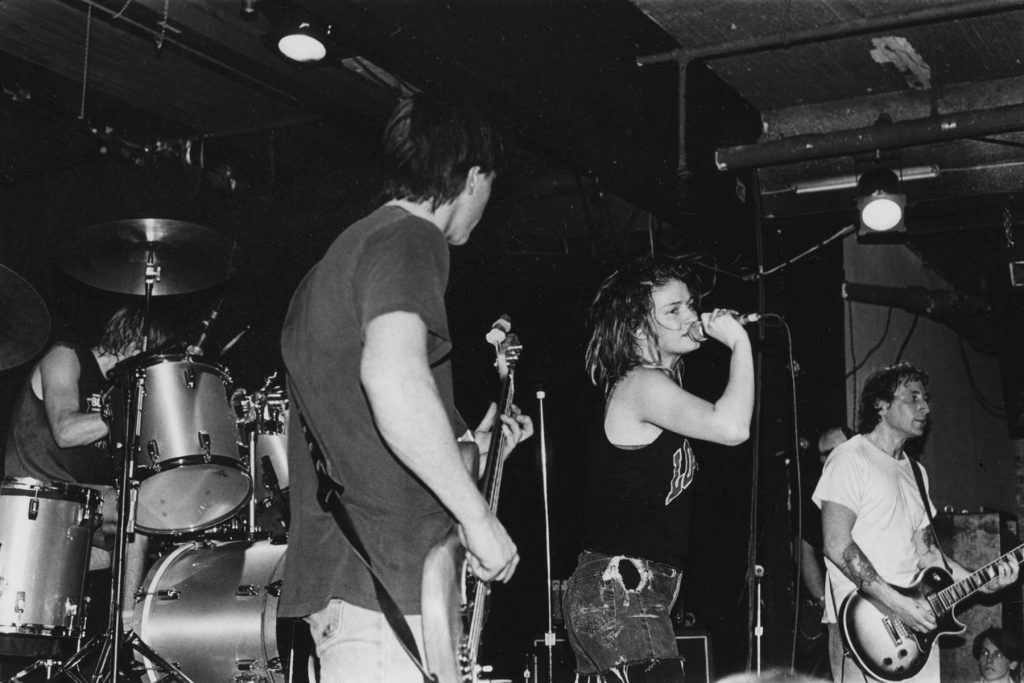
Mia Zapata’s Killer Has Died. Peers Remember the Gits Singer’s ‘True Independent Soul’
Jesus Mezquia, the man convicted of murdering Seattle musician Mia Zapata, died in a hospital in Pierce County, Washington, on January 21st. He was 66 years old. His death was confirmed by the Washington State Department of Corrections, which declined to provide a cause of death, citing state privacy laws. Mezquia had been serving a 36-year sentence, which was overturned in August 2005, then subsequently reinstated by the state Court of Appeals in January 2009.
“Mia Zapata was an extraordinary human being. She was a beloved friend, a gifted songwriter, musician, visual artist, and performer,” her three surviving bandmates — guitarist Andy Kessler, bassist Matt Dresdner, and drummer Steve Moriarty — said in a statement to IndieLand. “Rather than focusing on her death, we prefer to remember her friendship, talent, humor, and the incredible art and music she left to the world.” (Via Moriarty, Zapata’s family declined to comment for this story.)
“I was actually thinking for years how I would react when he was released,” Moriarty tells IndieLand. “He affected a lot of people in my life in a very negative way for many years. He was a profoundly distracting influence on my life for the last 25 years. Good riddance.”
blogherads.adq.push(function () {
blogherads
.defineSlot( ‘medrec’, ‘gpt-dsk-tab-article-inbody1-uid0’ )
.setTargeting( ‘pos’, [“mid-article”,”mid”,”in-article1″,”mid-article1″] )
.setSubAdUnitPath(“music//article//inbody1”)
.addSize([[300,250],[620,350],[2,2],[3,3],[2,4],[4,2]])
;
});
Mezquia’s death marks an end to one of the darkest and most tragic episodes in rock music. On July 7th, 1993, Zapata, the lead singer of the punk band the Gits, was raped and murdered. She had spent most of the night before at the Comet Tavern, then went to a friend’s apartment in Seattle’s Capitol Hill neighborhood before leaving on foot at around 2 a.m. Her body was found at 3:20 a.m. on a deserted street less than two miles away from the bar. She was 27 years old.
Her life story and murder have been the subject of episodes of the Investigation Discovery Channel series Dead of Night, Unsolved Mysteries, 48 Hours, and the documentary The Gits. The case went unsolved for nearly a decade until Mezquia’s arrest in 2003.
The horrific and violent nature of Zapata’s death added to the dark cloud hanging over the scene, with multiple people in the music community that Zapata was part of falling under suspicion. “You can imagine, this vibe that sort of came over Seattle when it happened — people just not knowing [who did it],” Gits friend and collaborator Joan Jett says. “If it was one of their friends, you know, or an acquaintance, or an audience member, you just didn’t know.”
“Partly because it was a murder, Zapata’s death genuinely transformed the smaller, more local scene in which she was a leading light,” NPR music critic Ann Powers wrote in a 1994 Village Voice story. “Talking about Kurt [Cobain] with people in clubs and cafes, I actually feel his presence less than Zapata’s. She is mentioned over and over. Posters asking for information adorn the wall of the Comet Tavern … on some street corners, you can see the fliers made by friends a long time ago. There’s Mia’s warm, big, charming face, and the words: ‘Damn! Damn! Damn!’”
Years before Jett stepped into Cobain’s considerable shoes at the Rock Hall of Fame, she filled in for the Gits. It began when Jett wrote and recorded the song “Go Home,” for her 1994 album with the Blackhearts, Pure and Simple. The video — which was dedicated to Zapata and sought to raise awareness of her then-unsolved murder — shows an actress being pursued by a stalker onto a subway train, where she fends off an attack. Jett claims that MTV would not play the dedication at the end of the video for reasons unknown.
The band contacted Jett after seeing the video, and she would go on to record a live album and perform shows with the surviving members of the Gits in 1995 under the moniker Evil Stig (“Gits Live” spelled backward). “I was having fun, but I was also well aware of the heaviness of what we were doing and the message that we were trying to get out, which was, ‘Yeah, have fun, but be aware,’” Jett says. “We were directing it towards women, but it’s really towards anyone.”
blogherads.adq.push(function () {
blogherads
.defineSlot( ‘medrec’, ‘gpt-dsk-tab-article-inbody2-uid1’ )
.setTargeting( ‘pos’, [“mid-article2″,”mid”,”in-article2″,”mid-article”] )
.setSubAdUnitPath(“music//article//inbody2”)
.addSize([[300,250],[300,251],[620,350],[2,4],[4,2],[3,3]])
;
});
Zapata’s surviving bandmates organized a series of benefit shows to raise money to hire a private investigator to find her killer after her case had gone cold. Moriarty recalled that other bands, including Hootie and the Blowfish and Sonic Youth, donated money to the cause as well. Home Alive: The Art of Self Defense, a 1996 benefit album in Zapata’s memory, featured contributions from Nirvana, Soundgarden, Pearl Jam, and others to raise funds for Home Alive, an organization that encourages women to learn self-defense.
Advances in DNA testing eventually provided the crucial evidence that solved the case. Swabs taken from Zapata’s body confirmed the presence of saliva. The swabs were preserved for eight years until a Seattle Police detective submitted them to the Washington State Patrol Crime Laboratory for DNA analysis. The samples yielded two DNA profiles — one matching Zapata, the other belonging to an unidentified male. The profile of the unidentified male was entered into the FBI’s database — which contained nearly 2 million DNA samples — in June 2002. It did not generate any matches at the time.
“Her legacy should be beautiful, strong punk-rock music coming from a woman’s perspective, because that’s who she was” – Joan Jett
Six months later, Seattle Police got a break when Washington State Patrol was informed of a match for their sample with the DNA of Mezquia. It was the genetic equivalent of a smoking gun. According to a court document, “The frequency of the profile in the United States is one in 1.5 trillion. At the time the match was found, Mezquia resided in Florida [and] was on probation following a 2002 Florida felony conviction for possession of burglary tools. As a condition of his probation, he was required to submit two cheek swab samples.”
It was subsequently discovered that Mezquia had been living in Seattle between 1992 and 1994, approximately a mile and a half from the site where Zapata’s body was discovered. The woman he was living with at the time was out of town on the night of the murder.
Seattle Police arrested Mezquia in Miami on January 10th, 2003. While testifying during the trial, Moriarty taunted Mezquia in his native Spanish in an attempt to provoke him. In March 2004, a King County grand jury found Mezquia guilty of murder in the first degree.
Mezquia, originally from Cuba, is thought to have come to the United States in 1980 as part of the Mariel Boatlift. He accumulated a lengthy criminal record over the years in multiple states: convictions for aggravated battery of a pregnant woman in 1997; kidnapping, false imprisonment, robbery, and indecent exposure in Florida during the Eighties; and battery of a spouse and assault to commit rape in California in the late-Eighties and early-Nineties, according to Seattle newspaper The Stranger.
blogherads.adq.push(function () {
blogherads
.defineSlot( ‘medrec’, ‘gpt-dsk-tab-inbodyX-uid2’ )
.setTargeting( ‘pos’, [“mid”,”mid-articleX”,”in-articleX”,”mid-article”] )
.setSubAdUnitPath(“music//article//inbodyX”)
.addSize([[300,250],[300,251],[3,3],[620,350]])
.setLazyLoadMultiplier(2)
;
});
According to a Seattle Times report, Mezquia relocated to Seattle in 1992 to be with an unidentified woman who had moved to the area. The two wound up moving into her mother’s home in Seattle’s Beacon Hill neighborhood. Mezquia and his girlfriend eventually moved to an apartment in the Leschi area. They broke up at some point in the summer of 1993, though they continued to live together. According to the Times, “The girlfriend, after catching glimpses of Mezquia’s anger, told the neighbor that she didn’t know what she’d gotten herself into and wanted to distance herself from him.” After she was able to get a car for Mezquia, he subsequently moved to Southern California, and later on, back to Florida.
Powers says that Zapata’s legacy, alongside her music, is the launch of the Home Alive movement. “I’m heartened to see how Home Alive helped in that regard, to educate women, and probably saved a lot of lives,” Powers says. But she also points out that the recent murder of Sarah Everard in England, under similar circumstances to Zapata’s — a young woman walking home alone — shows that the problem hasn’t gotten any better decades later.
“She certainly had the charisma, the vocal power, the musical talent to break through” – Ann Powers
“I really believe [Mia] was a true bohemian, a true independent soul, and would have remained on that path,” says Powers. “Having lived in New York, San Francisco, Los Angeles, Nashville, and Seattle, there are people who will never win a Grammy or sell a million copies of their hit single, but they remain crucial figures in their local community. If the Gits never broke through to a massive audience, Mia might have been one of those people.
“She certainly had the charisma, the vocal power, the musical talent to break through,” she adds.
“I think the Gits in general were on that trajectory to becoming a well-known, famous band because they had a fan base and great audience in the Northwest,” Jett adds. “They had great songs, and Mia had great stage presence. I’m sure they would have been whatever they wanted to be.”
Still, the question of what might have been is one that will always hang over Mia Zapata’s life story. “I still know people who knew Mia then,” Powers says. “They’ve gone on to do different things in their lives. I wish we could have seen what Mia would be doing now in that community.”
blogherads.adq.push(function () {
blogherads
.defineSlot( ‘medrec’, ‘gpt-dsk-tab-inbodyX-uid3’ )
.setTargeting( ‘pos’, [“mid”,”mid-articleX”,”in-articleX”,”mid-article”] )
.setSubAdUnitPath(“music//article//inbodyX”)
.addSize([[300,250],[300,251],[3,3],[620,350]])
.setLazyLoadMultiplier(2)
;
});
In the end, Jett says, it all comes down to the music. “Her legacy should be beautiful, strong punk-rock music coming from a woman’s perspective, because that’s who she was.”




